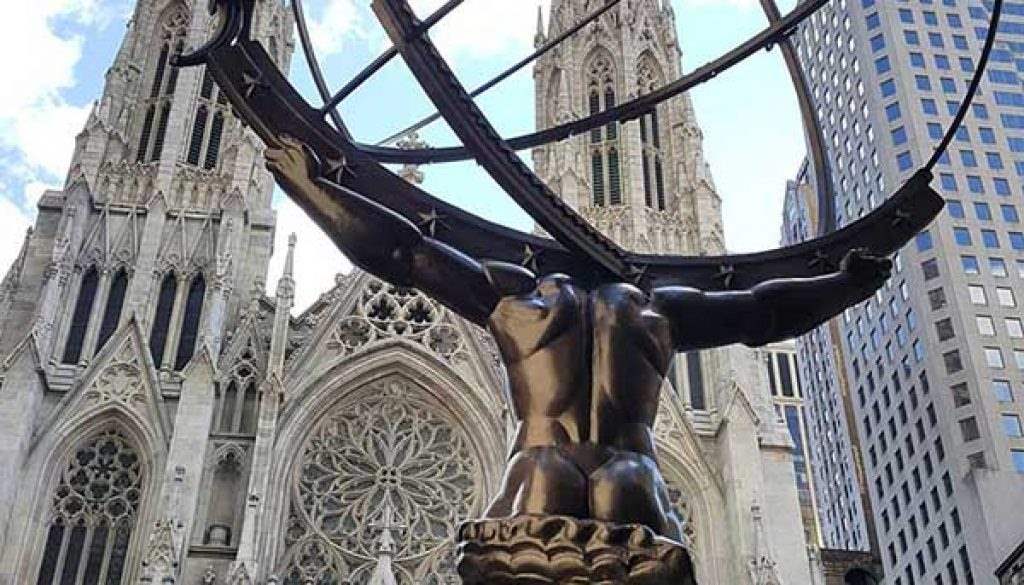Suggested One Day NYC Itinerary and Self-guided Tour
by: Max Vishnev, founder of CityRover Walks NY and licensed NYC tour guide
Are you visiting New York City for the first time? Will you only have a day or two to try cover as many of the famous places and attractions as possible?
If you answered “Yes” to one or both of the questions above, then this detailed One Day NYC itinerary and guide is for you!
You might also find our “Top 10 Must See Places to Visit in New York City” guide useful. It’s full of rich detail, including maps and places to eat and drink near famous NYC attractions. It complements this guide really well!
If you have any questions or are interested in customizing a private guided walking tour, feel free to browse our private tour offerings at https://cityroverwalks.com/tours. You can also drop us a line at [email protected], or call us at +1(347)464-9335. We’ll be glad to help!
2 notes before we dive in:
1. This one-day guide is geared toward first-time visitors, but repeat visitors should find it useful as well. Be prepared to walk a lot and to use the NYC subway system.
2. Obviously, it is impossible to see all New York has to offer in a single day, but this should give you a good feel for the city and some of its most famous places, buildings, and landmarks.
One of the landmarks included in this suggested one-day itinerary is the iconic Brooklyn Bridge. Check out this clip (featuring the author of this post) from a Canadian TV show called “America Over the Edge”:
Now without further adieu, let’s get your one-day NYC adventure started!
Table of Contents
Top of the Rock
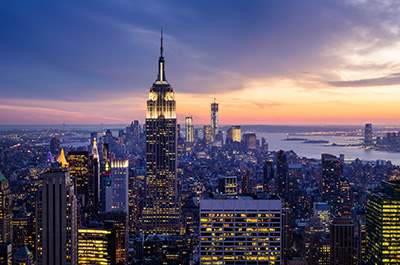
We suggest starting your day early with a morning visit to the popular observation deck at Rockefeller Center called Top of the Rock. Enter the flagship building, 30 Rockefeller Center, at 50th street between 6th Avenue and 5th Avenue (look for the neon “Observation Deck” sign).
It’s a great way to take in the city from the sky before exploring it on foot. You can’t really fully appreciate New York’s density, scale, visual diversity, and unique skyline until you visit Top of the Rock.
Top of the Rock FAQs
How do I get to Top of the Rock?
Top of the Rock is just a clever name for the observatory atop 30 Rockefeller Center, the flagship (and tallest) building in the entire 1930s-era complex. You’ll need to enter 30 Rockefeller Center and follow the signs for Top of the Rock. The best way to do that is to enter at 50th street, between 5th and 6th avenues. You’ll see a marquis with “Observation Deck” displayed on it. Enter there and follow the instructions of the staff.
Top of the Rock is open 7 days a week, from 9am to 12am. The first elevator goes up at 9am, while the last elevator leaves at 11:10pm. The closer you get there to the time it opens, the smaller the crowd will be, which not only means a faster security line but more room to walk around and admire the incredible views at the top.
The observatory goes from the 68th floor up to the 70th floor of 30 Rockefeller Center. There are stairs, escalators and elevators available to go from one level to the next.
Don’t worry, if you stick to the first level (the 68th floor), you will be completely surrounded by thick glass and far enough from the edge of the building where you wouldn’t be able to look straight down. That said, you would still be on the 68th floor of a Manhattan skyscraper, so if you have serious acrophobia, you might want to skip it and just get a cup of coffee or a bite to eat in the Dining Concourse, while others in your travel party enjoy the views and show you the pictures later.
It really depends. Are you coming in the slower months (January through early March)? If so, you can just buy tickets when you get there. But if you’re visiting during the busier months (which is the rest of the year, really) and you want to go on a Saturday, you’re better off buying tickets online. We have more info on ticket options below.
A standard adult ticket is $40 (plus 9% sales tax). They charge a $15 “sunset” surcharge if you want to go up there with everyone else that’s trying to catch the sunset from Top of the Rock (another reason to follow our advice and go there earlier in the day). Other options are their “Express Pass” for $85, and the “VIP” ticket, which is $125 before tax. Both allow you to skip lines, but the VIP ticket includes a tour and a photo pass) .
There are two main ways to get Top of the Rock tickets
Option 1:
Buy them online and reserve a specific date and time. This is the way to go if you know exactly when you will be going up there. The main risk with this option is that the weather may not cooperate and Rockefeller Center does not issue refunds due to weather conditions, though they may issue you a ticket for another date in case of inclement weather.
Option 2:
Buy your tickets at 30 Rockefeller Center in person. This is the better option if you are not sure about the date or want to check the weather forecast once you arrive in NYC. The ticket “office” is in the Dining Concourse of 30 Rockefeller Center (lower level). There are vending machines as well as several ticket agents inside. The line usually moves pretty quickly. The biggest risk with this option, especially during the peak tourism months in New York (late March through December), is that they may be sold out for certain time periods on a given day. For example, if you were to show up on a warm and sunny Friday in June hoping to go up with the first elevator at, you may discover that they are sold out. So it’s a trade-off between weather risk and ticket availability risk.
Whichever ticket option you choose, the views up at the top will be the same – amazing. You’ll see the Empire State in all its Art Deco splendor if you look south and 843 acres of Central Park if you look north. And who knows, maybe you’ll bump into Jimmy Fallon or one of the cast members of Saturday Night Live on your way out.
After returning back to ground level, there are lots of good options for a quick bite in the Dining Concourse, including Black Seed bagels, Ace’s Pizze, among many other good lunch options. And don’t forget Chip City for an amazing cookie from a popular local brand.
If you are a coffee connoisseur looking for a great cup of coffee in NYC, skip the Starbucks and head to Blue Bottle Coffee, located near the bathroom facilities in the Dining Concourse.
Next: Walk 2 minutes
Take the escalator from the Dining Concourse up to the main lobby of 30 Rock (which faces the Plaza and ice-skating rink)
30 Rock and Rockefeller Plaza
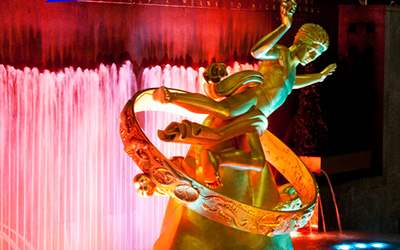
From the Dining Concourse, take the escalator back upstairs and check out the beautiful lobby of 30 Rockefeller Center before exiting. The fantastic mural on the main wall is called “American Progress” and was created by Jose Maria Sert, a Catalan artist, and completed in 1937. Abraham Lincoln is the tall figure in the top hat (left of center). The building looming in the background is the very building you are standing in (30 Rock).
A quick aside for art history (and drama) lovers: The Rockefellers originally awarded this very prominent commission to a famous Mexican muralist named Diego Rivera, who was a well-known Communist. His sketch for the mural was approved, but as the giant fresco was nearing completion, Rivera decided to add the face of Vladimir Lenin, the leader of the Russian Bolshevik Revolution. This act of artistic propaganda, needless to say, did not please his famously rich and very capitalist patrons. After refusing to remove Lenin, Rivera was quickly fired, his mural covered up, then unceremoniously chiseled off the wall piece by piece (it was a fresco, so it couldn’t be removed).
Now look up at the ceiling. Jose Maria Sert, who gladly replaced Diego Rivera, painted this incredible work as well. It is simply called “Time”. The colossal figure in the center is “Present”, who is flanked by “Past” and “Future”. He strikes a difficult balance between mankind’s past failures and accomplishments and the uncertain prospects and hopes for the future.
Exit through the revolving doors towards the flags of the Plaza. If you turn around, you’ll see the building’s name is chiseled onto the stone façade. The “Comcast Building” is actually the building’s third name. It was originally the “RCA Building” when it opened in 1933. Then, in 1988, it became the “GE Building”. The current name was made official in 2015. We prefer “30 Rock”.
If you gaze up while looking at the building’s façade, you’ll see a really stern-looking giant with a long white beard. That’s old man “Wisdom” pushing away clouds of ignorance to bring us Sound (left) and Light (right). This incredibly complicated work of art was designed by Lee Lawrie, who would go on to create Atlas on Fifth Avenue (more about Atlas later). The giant bearded sage was carved out of a single piece of limestone. And the glass background is comprised of 240 pieces of hand-cast glass blocks.
The reference to Sound and Light is no accident. The art of Rockefeller Center (created in the early to mid-1930s) was meant to inspire and lift people’s spirits during the Great Depression. Celebrating mankind’s recent achievements was a way to do that, so Sound can be viewed as celebrating the radio and the telephone, while Light might reference the relatively recent proliferation of electric light, as well as the development of the motion picture industry.
Now, if you turn around, you’ll see the flags that correspond to members of the United Nations (unless you are visiting during a national holiday or around Christmas season, when the UN flags are temporarily replaced). As we wrote in our post about the top places to visit in NYC, the Rockefellers played a vital role in the establishment of the U.N. Headquarters in New York City.
The Lower Plaza, where the famous ice skating rink is, draws large crowds in the colder months. Flying above the rink is the gilded Greek mythological figure of Prometheus, bringing fire (that he stole from Mount Olympus) to mankind (that he created out of clay), represented by the smaller male and female bronze figures in front of the Lower Plaza. This got Zeus really riled up, and as punishment, Prometheus was chained to a rock, while a vulture pecked out his liver every night. But then, his liver would grow back during the day, only to be pecked out again at night. That lasted for 30 years until Hercules killed the vulture and freed Prometheus.
Next: Walk 3 minutes
Walk up the promenade, also known as the “English Channel,” heading towards Saks on Fifth Avenue.
The French building will be on your right, the British building on your left. Once you reach Fifth Avenue, make a left and head towards the twin Gothic spires of Saint Patrick’s Cathedral. Across from the famous cathedral is the enormous Art Deco sculpture of Atlas holding up the weight of the world.
Atlas
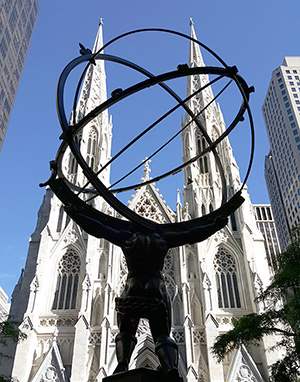
Atlas, according to Greek mythology, was the brother of Prometheus and a fellow Titan. Atlas is the largest sculpture in Rockefeller Center and the most impressive (rising 45 feet above the sidewalk!). It is supposed to represent “internationalism”, which explains its prominent placement in front of the International Building. According to Greek mythology, Atlas fought against Zeus and the gods of Mount Olympus for ten years and lost. His punishment was to hold up heaven and earth forever. That’s a long time to hold up anything, especially when you can’t even stretch or scratch an itch. Key takeaway: Don’t mess with Zeus, a lesson both Prometheus and Atlas learned the hard way.
For a great photo, stand behind Atlas. This view offers multiple contrasts: Bronze vs. marble, Art Deco vs. Neo Gothic, dark vs. light, Greek Mythology vs. Roman Catholicism.
And while you’re there, you’ll notice that it appears as if Atlas is kneeling towards Saint Patrick’s Cathedral. While that was not the intention of the artist, Lee Lawrie, this view allegedly placated an angry archbishop, who felt that the 7,000 kilogram bronze figure was a massive insult heaved upon the Roman Catholic institution right across Fifth Avenue. A mythological Greek Titan holding up the earth and heavens right across from the Cathedral was a slap in the face, in his view, until he stood behind Atlas and saw him “kneeling”.
By the way, residents of Queens (New York’s second-most populous borough) should be proud to know that the final plaster model of Atlas was cast in bronze in a Long Island City studio.
Next: Look across the street!
Are you finding this detailed guide helpful? Want to get it as a printer-friendly PDF in your inbox right now? Click on the link below to get on our email list, and we’ll send you this entire article in a flash. All you’ll have to do is hit “PRINT”!
Saint Patrick’s Cathedral
The iconic St. Patrick’s Cathedral on Fifth Avenue recently underwent a full restoration, which took 3 years and cost $177 million. This included the washing and polishing of the nearly 8,000 pipes that make up the main organ. The restoration was completed in the nick of time — a week before the visit of Pope Francis!
The land for the cathedral was acquired in 1858 by the Roman Catholic Archdiocese of NY at a time when the area was still largely undeveloped, which is hard to fathom today! It took two decades to build the magnificent cathedral, with the project costs being funded mostly by poor Irish immigrants contributing nickels and dimes. By the time it was completed in 1879, this section of Fifth Avenue had become “Millionaire’s Row”. Its neighbors, living in their stately mansions, didn’t look too fondly upon the new cathedral, given that most of them were “blue-blooded” Protestant families.
The splendid cathedral is open to the public, so walk inside if you have the time. The dimensions will stun you, as will the stained glass work. The Roman Catholic Archdiocese holds regular services as well.
Next: Walk 10 minutes
Walk south along Fifth Avenue for about 10 minutes until you reach the classical marble building with the two dormant stone lions in front at 41st street. You’ll know you’re walking in the right direction if the street numbers are going down (i.e. 50th, 49th, 48th…)Next
New York Public Library
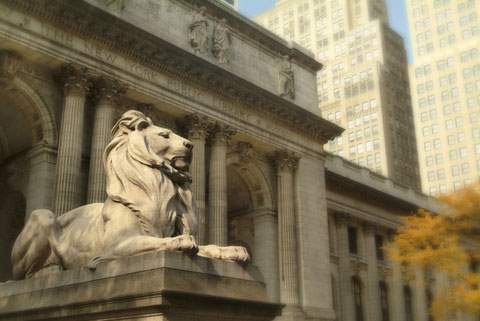
New York City has no shortage of stunning buildings, and the flagship NY Public Library on Fifth Avenue has to rank near the top. It is considered one of the best examples of the Beaux Arts style of architecture that was so popular in New York in the early part of the 20th century. In fact, some of the most famous buildings in the city were designed in this style, including Grand Central Terminal, NY Stock Exchange, Custom House, and the Metropolitan Museum of Art (though the original building by Calvert Vaux was in a different style). All of these famous landmarks were built during the so-called “City Beautiful” movement that became all the rage in New York City after the popular Chicago World’s Fair of 1893 that introduced America to the “Great White City”.
The Library is guarded by two massive stone lions. These friendly pussy-cats go by two different sets of names. Originally, they were called Leo Astor and Leo Lenox (named after John Jacob Astor and James Lenox, whose privately built libraries were combined to form this one). During the Great Depression, however, they were renamed Leo Patience and Leo Fortitude by then-mayor Fiorello LaGuardia to boost morale in a city crushed by the Crash of ’29.
Movie buffs reading this might recognize the classical façade from the opening scene of the original Ghostbusters (1984), or the tsunami scene from the 2004 apocalyptic thriller, The Day After Tomorrow.
You might also notice that the building is actually called the Stephen A. Schwarzman Building. What gives? Isn’t this the famous New York Public Library? Who is this Schwarzman guy and why is his name on the building? He is a private-equity billionaire whose net worth is estimated to be over $12 billion, and in 2008, he donated $100 million to the library to help fund a $1 billion overhaul and restoration. This enormous donation, the largest unconditional private donation to a public institution in New York City at the time, got his name to appear on and in the century-old building not once but five times! The Landmark Preservation Commission had to approve the carving of his name on the main façade.
The massive building itself, took over a decade to build (it took 2 years just to dismantle a giant stone reservoir that occupied the site), and when completed in 1911, it was the largest marble building ever constructed in the United States. It quickly earned the nickname the “People’s Palace” because it was not only classical and monumental but also free and open to all – whether you were a highly educated professor or a poor kid from the tenements of the Lower East Side.
If you have the time, go into the building. You’ll feel like you’re in a museum in Europe, not a library. And if you want to see one of the library’s architectural highlights, take the grand stairs (or the far less grand elevator) to the top floor and check out the stunning McGraw Rotunda, the famous Rose Reading Room is only open to the library’s official tour or library users.
The library has many rare books and documents, including the first Gutenberg Bible brought to America. It’s hard to believe that the ink (and the pages it’s printed on) dates back to 1455, when Johann Gutenberg printed this copy and approximately 179 other copies on his revolutionary invention – the printing press – in Mainz (Germany).
Another priceless object is a handwritten final draft of the Declaration of Independence, penned by Thomas Jefferson in the pivotal summer of 1776. The Library showcases this historic document every Fourth of July weekend.
Next: Walk 10 minutes
After leaving the library, head east on 41st street (the library should be behind you), also known as “Library Walk”. Be sure to look at the bronze plaques on both sides of the sidewalk. You’re in for some treats if you stop to read them. Our favorite is the following quote: “Truth exists, only falsehood has to be invented.”
When you get to Park Avenue, make a left.
Grand Central Terminal
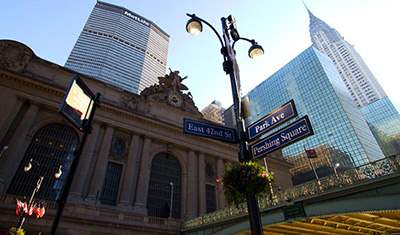
From the People’s Palace to another Beaux Arts beauty nicknamed the “Gateway to America.” Grand Central Terminal was completed in 1913, two years after the library, and was the largest train terminal ever built. It earned its nickname because New York City was receiving a record number of immigrants in the early 20th century – 1 million immigrants were processed in 1907 at Ellis Island, for example. Some stayed in New York, but many others took a train to Anywhere, America. Perhaps they had a sibling in Chicago or Detroit, or heard about abundant farmland in Iowa or Nebraska. To get there, they had to take a train. And for many, that meant getting to Grand Central Terminal.
But the enormous terminal was by no means used only by poor European immigrants looking to go West. It offered luxury travel for first-class passengers on super-fast modern trains with fancy names like “20th Century Limited” and the “Empire State” that could get you from NY to Chicago in style in just 16 hours. Wealthy customers and business travelers would enjoy red carpet treatment, luxurious accommodations, top-notch dining cars, and “Redcaps” to carry their luggage.
The terminal took 10 years to build at a staggering cost of $80 million (about $2 billion in today’s dollars) in the early 20th century and 10 years to restore in the 1990s (at a cost of $100 million).
To see a reminder of how neglected and dirty the Terminal’s celestial ceiling once was, find the Cancer zodiac and look for the dark rectangular patch near the crab’s claws. That dark patch is mostly tobacco and nicotine pollution accumulated over 80 years. The patch was intentionally left unrestored to remind people of Grand Central’s once-sorry state and to showcase its splendid condition today.
After exploring the Main Concourse, head downstairs to the Dining Concourse for a bite to eat, a beverage, or just for a rest. And while you’re there, look for the Oyster Bar (NY’s oldest) and test out the secret acoustic features of the “Whispering Gallery” in front of it. If you see others talking into corners, follow their example. You just need someone to stand in the opposite corner from you, so people won’t think you’re crazy.
Food options inside Grand Central
1. Head downstairs to the Dining Concourse, which features an impressive variety of casual lunch options, including great ethnic foods, as well as the popular burger chain, Shake Shack, and the iconic Oyster Bar circa 1913. You can also treat yourself to a slice of cake from Magnolia Bakery!
2. Or stay on the Main Concourse level and head towards the 42nd street exit. You’ll see the popular City Winery inside the splendid Vanderbilt Hall. A beautiful grand setting for a drink or a meal.
3. For a fancy cocktail and small bites in a 1920s-inspired “speakeasy bar” setting, head up to the Campbell Bar (formerly known as the Campbell Apartment).
5. You can also dine in style removed from the fray, while overlooking the Main Concourse from the West Balcony. Just head up the grand staircase to Cipriani Dolci for a high-end Italian meal and a cocktail above the foot traffic and below the “celestial” ceiling.
OK, meals aside, let’s get back to our self-guided tour!
Next: Walk 5 minutes
If you exit Grand Central on the Lexington Avenue side (or exit on 42nd street and make a left), you can visit the Art Deco lobby of one of New York’s most famous and iconic skyscrapers – the Chrysler Building.
Chrysler Building
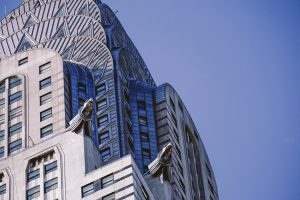
The Chrysler Building is instantly recognizable, even if you don’t know it by name. You’ve seen it in countless photographs, TV shows, and movies. Most recently, Will Smith (Agent J) jumps off the famous skyscraper to travel back in time in Men in Black 3 (2012).
Hollywood time-travel aside, the building serves as a terrific contrast to Grand Central Terminal. Classical vs. modern (Art Deco was the epitome of modern architecture in the 1920s and 30s), horizontal vs. vertical, trains vs. cars. The building was commissioned by Walter Chrysler, the automobile kingpin, who wanted to showcase his success with the ultimate phallic symbol for extremely wealthy early 20th century industrialists – a really tall building.
As his building was going up in 1929 on 42nd street, a major Wall Street bank was constructing another skyscraper in the heart of the Financial District in Downtown Manhattan.
That building, called 40 Wall Street, was completed first to become the world’s tallest in April of 1930. However, Walter Chrysler had a trick up his sleeve: A 125-foot stainless steel needle erected last minute to claim the title of world’s tallest a month after 40 Wall Street was completed.
But Chrysler’s celebration was short-lived because the Empire State Building beat his skyscraper just 11 months later. The only consolation was that the Chrysler was (and remains) the world’s tallest brick skyscraper supported by steel. In fact, nearly 4 million bricks were laid by hand during its construction. What’s even more amazing is that despite the extreme height (total height of 1,046 with the spire) and hectic pace (4 floors per week) not a single worker died during the construction process!
For a terrific read about the famous race for the world’s tallest building, check out a book called Higher by Neal Bascomb.
To learn much more about these (and other) famous Midtown landmarks, check out our private walking tour of “Must See” Midtown NY attractions.
Next: Take the Subway! About a 10-minute commute.
We are going to head Downtown towards the Brooklyn Bridge using the NYC subway. Deep breaths — you’ll be fine!
Look for the subway signs on the Grand Central side of Lexington Avenue and 42nd street. Enter the station, use our detailed subway guide to figure out how to buy a Metrocard or pay with OMNY, then head for the 4/5/6 subway in the direction of Downtown & Brooklyn. Do not go down the steps to the platform if the sign shows “Uptown & The Bronx”, as that would take you in the opposite direction. Take either the 4, 5, or 6 train downtown to the “Brooklyn Bridge/City Hall” stop, then exit to the street and look for the pedestrian ramp to the Brooklyn Bridge.
Brooklyn Bridge
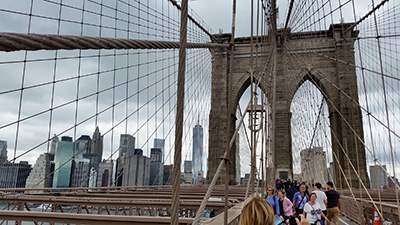
Walk over the famous 1-mile suspension bridge from Manhattan to Brooklyn. Please stay to the right of the dividing line, unless you want to be yelled at (or worse, hit by) a speeding cyclist. We are especially talking to you Britons and Aussies, with your strange “left side of the road is the ‘right’ side” customs.
Once you reach the first Gothic tower of the bridge, you’ll notice a bronze plaque on the center stone column. The top line on the plaque reads: “Erected by the cities of New York and Brooklyn.” The key word here is “cities”. When construction of the bridge was scheduled to begin in 1869, it was to connect the separate cities of New York (then, just Manhattan, but already the largest city in America) and Brooklyn (America’s 3rd largest city – behind New York and Philadelphia at the time). In fact, the two identical Gothic towers — still so iconic 133 years later – were designed to serve as timeless monuments to the two great cities the bridge was to unite.
Towards the bottom of the same plaque, you’ll see two names under “Engineers”: John A. Roebling and Washington A. Roebling. This famous father-and-son duo built this incredible span that for the first time physically connected America’s largest and third-largest cities.
Unfortunately, they didn’t build it together. A freak accident at a ferry landing on the Brooklyn side of the East River crushed John Roebling’s right foot, just as he was preparing to start construction on what was supposed to be his masterpiece. His toes were promptly amputated (without any kind of anesthetic), and he died 3 weeks later in excruciating pain after developing gangrene and tetanus.
The bridge’s brilliant designer (and its Chief Engineer) was now dead, and construction hadn’t even begun yet! Panic ensued, since the bridge was already considered “unbuildable” at the time, and now the only man in America deemed qualified to build it was dead. Luckily, cooler heads eventually prevailed and nominated his eldest son – Washington – who was chosen to replace the deceased Roebling.
Thus, 32-year-old Washington Roebling assumed his father’s position as Chief Engineer and was now tasked with the unenviable task of taking his father’s designs and figuring out how to actually build the bridge – one which would be the world’s longest suspension bridge by far. No pressure!
Tragically, not only would more men die during its 14-year construction, but Washington himself would become disabled in the process from a mysterious condition that became known as the “bends”.
If you walk to the Brooklyn tower, you’ll notice another bronze plaque. The first name listed is Emily Warren Roebling, who was Washington’s wife. She gets top billing on the plaque because, as Washington himself stated, the Brooklyn Bridge would not be built without her involvement and contributions. She sat by her husband’s bedside for over a decade, as the disabled engineer guided the enormous project along using his trusted wife to be his eyes and ears. She became the public face of the project and is considered the first female civil engineer in America. The quote on the bottom of the plaque sums it up: “Behind every great work we can find the self-sacrificing devotion of a woman.” Go Emily!
Next: Exit Bridge on left side
Get off the bridge by taking the stone staircase on the left (do not follow the bike path along the ramp!).
Sad historical aside: These stairs were the site of a terrible tragedy a week after the opening of the bridge, when unfounded panic caused a human stampede that resulted in 12 people being crushed and trampled to death on this very staircase.
Once down the stairs, make a left and head downhill. Walk 3 minutes.
Welcome to Brooklyn, New York City’s most populous borough, home to more than 2.6 million people!
Dumbo, Brooklyn
When you reach Water Street you can take a great photograph from a famous spot in a trendy post-industrial neighborhood now called “Dumbo” (which stands for Down Under the Manhattan Bridge Overpass). The street scene features converted brick factories and the steel tower of the Manhattan Bridge, with the Empire State Building visible straight down the middle on a clear day. This same shot (without the Empire State Building) was used on the movie poster for the 1984 gangster saga, Once Upon a Time in America, starring Robert De Niro.
Make a left on Water Street and walk a few blocks to Old Fulton Street. Here, you can get a good burger from Shake Shack, delicious pizza from Juliana’s, or your pick of artesenal ice cream from Brooklyn Ice Company, Van Leeuwen, or our local favorite for odd flavors, OddFellows. Or walk into the massive and recently gut-renovated Empire Stores warehouse complex, a mid-19th century coffee warehouse now home to West Elm, restaurants, a cafe, and even a public rooftop viewing area with great views of the East River and the Brooklyn Bridge!
And if you want to learn more about the Brooklyn Bridge and Brooklyn, check out our popular private tour over the Brooklyn Bridge and into Dumbo and Brooklyn Heights.
Next: Walk 3 minutes
Walk along Water Street, past the landmark brick Tobacco Warehouse (circa 1860), with a new theater space inside that is home to St. Ann’s Warehouse, an innovative non-profit theater company. Look for the ferry landing on your right when you reach Old Fulton Street.
East River Ferry
After enjoying breathtaking views of the Downtown Manhattan skyline from the water’s edge at the Fulton Ferry Landing buy a one-way ferry ticket from the NYC Ferry vending machine ($4 per ride or 10 for $27.50). For the latest seasonal ferry schedule, check out the NYC Ferry website and click on “East River”.
Make sure you take the ferry heading to “Pier 11/Wall St” not the one that has the sign for “Midtown/34th St”.
The short ferry ride you’ll experience is the only way residents of Brooklyn were able to commute to Manhattan before the completion of the Brooklyn Bridge in1883, which was fine in nice weather, but not so much during really cold winters, as the river tended to freeze.
The first commuter ferry (the Fulton Ferry) began service here in 1814 thanks to Robert Fulton’s successful commercialization of steam engine technology to power ships. Sadly, Fulton died of pneumonia just a year later. This reliable ferry service made Brooklyn an attractive “suburban” destination for some New Yorkers, which helped Brooklyn grow quickly to become America’s 3rd largest city by the middle of the 19th century.
Today, the ferry ride from Brooklyn to Manhattan actually takes you from New York’s most populous borough (with 2.7 million residents) to its most famous but only 3rd-most populous borough (behind Brooklyn and Queens). So two centuries after the launch of the Fulton Ferry, Brooklyn is home to a million more people than Manhattan, a figure that would be very hard to imagine in 1814.
Next: Get off the ferry and head to the edge of Wall Street (3 minute walk)
Hungry? Thirsty? Need a coffee fix?
When you reach Wall Street, which is perpendicular to the East River, look for Westville (110 Wall Street) for a great sit-down lunch option, or walk a bit further along the street to sweetgreen (67 Wall Street), a very popular casual/healthy lunch spot. Lastly, if you want or need a really good cup of coffee, check out La Colombe (67 Wall Street), a highly-regarded specialty coffee house.
Wall Street
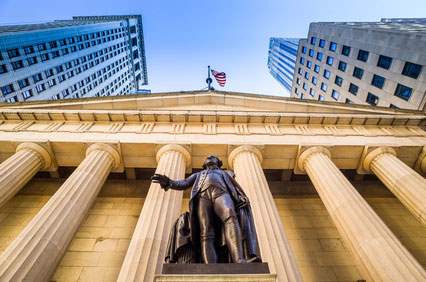
The name “Wall Street” may be synonymous with money and power, but it’s actually named after a wooden wall built in the 1650s. Erected by the Dutch after the outbreak of the first Anglo-Dutch War at the northern edge of New Amsterdam, this wall (which ran from the East River to the Hudson River) proved utterly useless, since the English attacked from the sea and not by land (insert self-administered palm slap to the forehead if you’re Dutch). The wall was broken down by the end of the century and used for firewood and free lumber. But the wall lives on in the famous street name.
As you stroll down Wall Street today, one thing that would never come to mind is slavery. Unfortunately, that is a big part of the early history of our great city. The slave trade was an important part of the local economy going as far back as our Dutch days as New Amsterdam. The Bloodless Surrender to the British in 1664 did not stop this heinous but profitable trade. In fact, in the 18th century, there was a bustling slave market at the foot of Wall Street, close to where you got off the ferry (look for the recently installed historical plaque near the corner of Wall and Water streets). Slavery wasn’t abolished in New York State until 1827!
As you pass William Street, notice the very tall skyscraper on your right with the gilded “Trump” name on the façade. That is 40 Wall Street, the building that lost to Chrysler just a month after becoming the world’s tallest. Donald Trump bought it in 1995, and, not surprisingly, quickly put his name on it in very large font. It remains a commercial building today. 40 Wall Street (to use its original name) recently fell out of the top 10 tallest buildings in New York City.
On the next corner, you will reach what’s considered the “heart” of Wall Street at the intersection of Wall and Broad Street. Here you’ll find the New York Stock Exchange (circa 1903) on your left and the Federal Hall Memorial on your right. The oversized bronze statue of George Washington commemorates the spot where the heroic Revolutionary War General of the Continental Army was sworn in as America’s first President on April 30, 1789.
Of the 8.8 million people that call New York home, how many do you think know the fact that Washington became our first president on Wall Street or that New York City was America’s first capital? Our guess is probably not many.
Speaking of statues, be sure to get a photo with “Fearless Girl” standing up to all the male big-shots at the Stock Exchange.
Across from Washington is the nameless sturdy-looking stone building that looks short compared to the skyscrapers around it. This used to be the J.P. Morgan headquarters, also known as the “House of Morgan.” Look for the shrapnel holes on the Wall Street side of the building (23 Wall St), which are remnants of an explosion that shocked Wall Street on September 16, 1920. A terrorist act, by the way, that remains an unsolved crime a century later, though Italian anarchists were blamed.
For a great cup of coffee while you’re exploring Manhattan’s Financial District (or FiDi, as it’s called today), check out our NYC coffee guide. Oh, and if you get a craving for a great NYC bagel while exploring Downtown, stop by Leo’s Bagels on Hanover Square, or head down Stone Street for a sit-down meal and a drink, inside or out (in the warmer months).
Next: Walk 3 minutes to the end of Wall Street (where it hits Broadway)
Click Here For Free PDFTake this guide with you on the road as a free and printer-friendly PDF file! Click on the link below to get on your email list, and we’ll send it to you in a “New York Minute”!
Trinity Church
Head west for one more block along Wall Street until you reach Trinity Church, which once towered over Wall Street. This is the third Trinity Church on this site. The first one burned down during the American Revolution, while the second had to be taken down due to structural damage. The church you see today was built in 1846 and is considered one of the best examples of Neo Gothic architecture in the United States.
Some of the most prominent New Yorkers are buried in the church’s graveyard, including Robert Fulton, whom we met earlier. To the left of Fulton lies buried one of America’s Founding Fathers and one of the most famous New York historical figures – Alexander Hamilton. Hamilton, who was America’s first Treasury Secretary, died at the age of 47 in 1804, a day after a duel with his archrival, Aaron Burr. Who would have thought that two centuries after his tragic death, Hamilton would be the star of a smash-hit Broadway musical that bears his name?
By the way, Hamilton’s wife, Eliza, who is buried nearby, outlived her husband by 50 years!
Next: Walk 3 minutes south along Broadway (same direction as car traffic)
Charging Bull
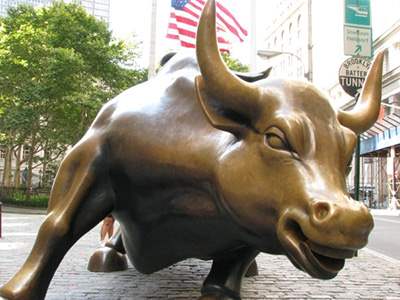
This 3.5-ton bronze bull at the southern tip of Broadway is often referred to as the “Wall Street Bull”. In fact, many tourists wandering up and down Wall Street will ask where the famous bull is located. There is only one problem – it’s not on Wall Street.
The Wall Street connection is two-fold. First, a bull is a symbol of a strong (rising) stock market. When stocks are steadily rising, finance types talk about a “bull market”. On the other hand, if stocks are falling sharply, it’s a “bear market”. The simple explanation for the bull and bear monikers is that a bull charges and uses his horns in an upward motion, while a bear usually pounces on his victim (downward motion).
Second, the giant bronze bull was originally dropped off in front of the NY Stock Exchange, in the heart of Wall Street, right before Christmas in 1989. So that might help explain the confusion.
It was the idea of a sculptor named Arturo Di Modica, who wanted to celebrate the “can-do” spirit of America, and New York in particular, where a shoeshine boy can one day become a successful trader.
He and some friends dropped off the bull in front of the Christmas tree outside the NY Stock Exchange in the middle of the night. But the chairman of the Exchange wasn’t too pleased and got the NYPD to take it away by the end of the day. Luckily, it soon found a permanent home at the tip of Broadway. And for nearly 30 years, people from all over the world (as well as Wall Street traders) have rubbed its horns and testicles for good luck in business and romance, respectively.
Next: Enter the small park with the black iron fence located right behind the Charging Bull
Bowling Green
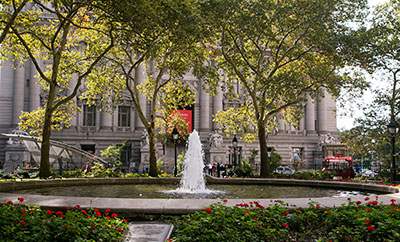
Just behind the bull is the New York’s first public park – Bowling Green. If the name sounds strange to us today, that’s because we don’t go bowling on the lawn on Sunday afternoons anymore (unless you are British or Scottish). But when the park was officially created in 1733, “bowling on the green” was a popular British pastime (a few centuries before Netflix).
This little circular park was also the site of a famous revolutionary scene. After New Yorkers heard the Declaration of Independence read to them for the first time on July 9, 1776, they ran to Bowling Green to pull down the biggest symbol of the oppressive English monarchy – a gilded equestrian statue of King George III. But pulling down the giant statue and chopping off the king’s head didn’t end the scene of revolt, as the fervent crowd proceeded to saw off the finials on top of the cast-iron fence that resembled crowns.
You can touch the rough and uneven surfaces on the original fence today to connect with the American Revolution.
Next: Exit the small park and come to a massive classical building with four female figures in front
Custom House
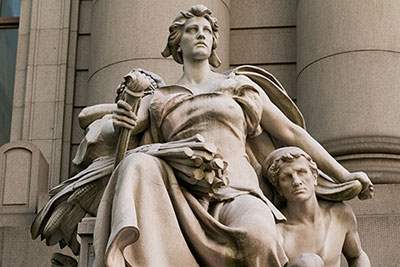
Just behind New York’s oldest park is one of the most beautiful buildings in New York City – the Alexander Hamilton Custom House.
This Beaux Arts beauty built in 1907 gives you an idea of how important the customs house was to cities with major ports. And New York being the largest city and the busiest port in America in the early 20th century had to have a building to reflect the importance of New York’s shipping industry. And it wasn’t just important to New York but to the country as a whole, since the US government generated about 2/3 of its revenue from collecting taxes on goods arriving on ships before the introduction of the Federal Income Tax in 1913.
The four large female figures in front of the classical façade represent Asia, the Americas, Europe, and Africa (from left to right), reflecting the global nature of trade and shipping.
The Custom House sits on the site of Fort Amsterdam, which was built by the Dutch in the 17th century to protect New Amsterdam from attacks by land or sea (including potential ambushes by Native American tribes). It is more than a little ironic that today the building houses the National Museum of the American Indian.
Next: Walk 3 minutes south along Whitehall Street to the Staten Island Ferry Terminal
Staten Island Ferry
Continue walking south past the Custom House (Battery Park will be on your right) until you reach the Staten Island Ferry terminal at the southern tip of Manhattan. This is a great and free way to enjoy scenic views of the NY Harbor, Statue of Liberty, Ellis Island, and surroundings while avoiding ticket lines and airport-style security screenings (which you would go through if you chose to take a ferry to Liberty Island and Ellis Island from Battery Park).
The Staten Island Ferry departs from the Manhattan terminal every 30 minutes on the hour and half hour (i.e. 12:00, 12:30, 13:00). You can view the schedule here. The ferry ride to Staten Island takes about 25 minutes, then you’ll have 5 minutes to get off one boat and run around the corner to get on the next boat back to Manhattan. If you miss that boat, you’ll have to hang out in the Staten Island Ferry terminal for 30 minutes (there are bathrooms, seats, and shops for snacks and refreshments, as well as two fish tanks for your viewing pleasure).
So all in all, budget 60 to 90 minutes for the round trip journey. But try to get there before rush hour (5pm). Otherwise, the ferry will be pretty crowded and you won’t be able to enjoy the views.
Next: Get on the right side of the boat en route to Staten Island to enjoy views of Ellis Island and the Statue of Liberty
Statue of Liberty
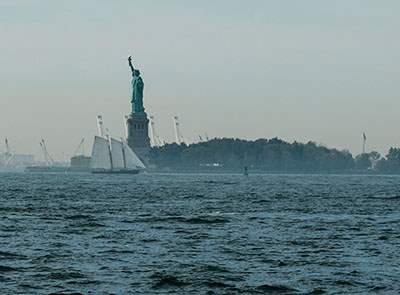
The statue needs no introduction. This French gift has been a welcome sight in the harbor since it was unveiled in October of 1886. Of course, in 1886, when the city skyline was still dominated by church steeples, she appeared even taller than she does today.
Fun facts about the Statue of Liberty
Lady Liberty looks green because her “skin” is comprised of very thin sheets of copper hammered by hand in Paris. Copper oxidizes over time, which makes it appear green. She was brown originally! Feel free to use that during your next trivia night.
If you were to peel back her skin, you’d discover that the famous Lady has an iron framework. This metal “skeleton” was designed by Alexandre-Gustave Eiffel, whose name graces the most famous structure in France (and tallest structure in the world until the completion of the Chrysler Building and its steel spire), which he designed right after the Statue of Liberty.
Eiffel did not design the statue itself. That was fellow Frenchman Frederic Auguste Bartholdi, who wanted to create a colossal female figure to present to America in time for America’s centennial celebration. Unfortunately, all we got for our 100th birthday in Philadelphia was her giant arm holding the torch. It would take another decade for the completed statue and the stone pedestal she stands on to be unveiled on Bedloe’s Island (now Liberty Island).
Millions of immigrants would break into tears of joy at the site of the enormous Liberty Enlightening the World (the statue’s official name) after surviving a 2-3 week ordeal in the steerage compartment of a huge ocean liner crossing the Atlantic. For them, she was the ultimate symbol of hope, freedom, and a new start.
But before they could start a new life in America, they would first have to be “processed” on Ellis Island.
Ellis Island
Just north of the Statue of Liberty is Ellis Island. 12 million immigrants were processed here (most of them between 1892 and 1921). The impressive French Renaissance Revival building located on the island, which served as the main building, now houses the Ellis Island National Museum of Immigration. This structure is important not just for immigrants but for a hundred million Americans whose ancestors were processed here.
This was the “Island of Hope” for the millions of poor hungry souls coming to America for a better life. Sadly, it was also the “Island of Tears” for the approximately 2% who were rejected and sent back to Europe. Reasons for rejection were many, but the most common were: “Insane, old and lame, infected with a loathsome disease, criminal, prostitute, contracted laborer, anarchist.”
So if there is an anarchist or lunatic in your family tree, then he or she must have gotten past the inspector.
Next: Time for a much-deserved break back on solid ground!
Stone Street
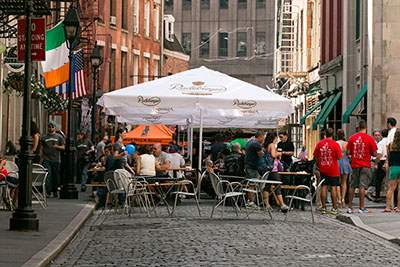
After returning from Staten Island take a break for food and drinks on Stone Street, the first paved street in New York. This little cobblestone street (just a 5-10 minute walk from the Ferry Terminal) is one of the best places Downtown to get a meal and a drink without breaking the bank. There are several pubs and restaurants to choose from and plenty of communal outdoor seating in the warmer months.
The street was the first one paved with stone in New Amsterdam in the 1650s. In the 1990s, after decades of neglect, it was restored, repaved and has become a great dining destination in the heart of the Financial District, also known as FiDi, since we love acronyms in NYC.
If you are interested in learning more about some of the most famous Downtown places, buildings, events and historical figures, check out our private Downtown NYC “Must See” walking tour.
Next: Time for the final leg of this self-guided tour!
Federal Reserve Bank of New York
Once you’ve satiated your thirst and hunger on Stone Street, it’s time for the final stretch of your one-day NYC adventure! Head north along William Street past Wall Street until you reach Liberty Street (a short walk from Stone Street). When you get to Liberty Street, make a left and you’ll reach a building that, despite not being very tall, is quite intimidating to look at. This fortress-like building, with the bulging stone facade and crime-deterring wrought-iron work is the Federal Reserve Bank of NY, arguably the most important of the dozen regional banks that together comprise the Central Banking system of the United States.
The block-long structure, completed in 1924 was designed to instill a sense of confidence, security, and safety, in a country that had only created the Federal Reserve in 1913. But there was another very practical reason for the building’s impenetrable appearance: It is believed to be the largest gold repository in the world, housing approximately 500,000 individual gold bars, most of which are owned by foreign banks. The gold was brought over the Atlantic during and after World War II and is kept 80 feet below ground (at bedrock level) in what’s definitely the safest basement in New York City.
Next: Walk 5 minutes
Follow Liberty Street west, cross Broadway, and walk another couple of minutes until you reach the South Pool of the 9/11 Memorial.
9/11 Memorial & Museum

The Memorial was designed by NY-based architect, Michael Arad, who was chosen as the winner of an international design competition in 2003, which drew 5,201 entries. The Memorial is comprised of twin pools representing the approximate footprints of the Twin Towers. We use the word “approximate” because the pools are actually 31% smaller than the footprints of the original towers. The architect, who was just 34 years old at the time he won the competition, called his submission “Reflecting Absence.”
The twin pools are surrounded by bronze parapets bearing the names of the nearly 3,000 victims who died on September 11, 2001, as well as the six people who died in the February 1993 bombing of the World Trade Center (when a van loaded with explosives blew up in the basement-level garage of the North Tower). More than 1,000 people were injured that day, including many first responders.
While the Memorial is a public space accessible at street level to all, the Museum (which is the downward-sloping structure between the two Reflecting Pools) requires timed admission tickets (we strongly suggest buying them ahead of time, if you plan to visit) and has hours of operation (open every day except Tuesday from 9am to 7pm. Last entry is 5:30pm).
Most of the Museum artifacts are located 70 feet below ground, the bedrock foundation level for the Twin Towers. These include a burned and damaged NYC fire truck, as well as steel tridents from the facade of one of the Twin Towers.
Here are a couple of tips before visiting the 9/11 Museum
- Give yourself at least 2 hours
The 9/11 Museum is not something to be rushed through, nor should it be a quick “Check!” on your NYC to-do list. While the Memorial can be seen and experienced in as little as ten or fifteen minutes, you really need at least a couple of hours to do the Museum justice. If you don’t have the time, save it for another trip.
- Expect a very emotional experience
This may sound very obvious to anyone old enough to remember what happened that day, but with many visitors coming to NYC with children and young adults, it is an important reminder nonetheless. After all, the Museum is designed to tell the story of 9/11, the worst terrorist attack in American history, particularly to those who weren’t even born yet. In addition to graphic and gut-wrenching audio and video recordings, it also holds the unidentified remains of many of the nearly 3,000 victims who perished on that terrible day.
- Expect crowds
The Museum entrance lines outside become quite long, especially on weekends between March and December. So plan ahead (purchasing your tickets online is a good first step).
To avoid ending on such a heavy note, we also want to mention one of the most striking additions to the redesigned World Trade Center:
WTC Transit Hub/Oculus
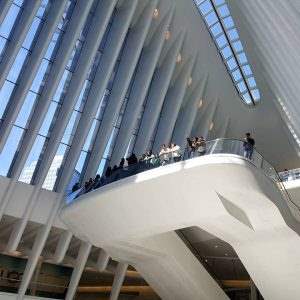
Santiago Calatrava’s $4 billion “winged bird about to take flight,” which opened just a couple of years ago, has quickly become one of the most popular attractions in New York. Officially a transit hub connecting the subway system to the PATH train to NJ, the Oculus is also a huge mall operated by Australian-based Westfield (a global mall operator). When you step in, you might feel like you’re either inside a spaceship or a whale (like in Finding Nemo).
It’s a really unique (and VERY white) public space that’s definitely worth visiting while you’re Downtown. And as a grand finale, head down to the bottom level and walk west, following the signs for Brookfield Place. You’ll walk through a gleaming white corridor that will feel a bit like walking on the Star Trek Enterprise (not that we would know what that’s like, but that’s beside the point). You’ll then take an escalator back up to street level and emerge inside the glass walls of Brookfield Place, right across the road from One World Trade. If you walk inside and past all the fancy global fashion chains, you’ll find palm trees (yes, we have real palm trees in Manhattan!) in what’s called the Winter Garden. Head to Le District to your left for a glass of wine and some French food (open til 8pm) or upstairs to Hudson Eats, a very popular modern food hall featuring lots of great local eateries and Hudson River views (open til 8pm).
Phew — We did it guys! Your feet will probably be as tired after this self-guided itinerary as our fingers are right now from typing all this. So thanks for reading our 1-day Suggested NYC Itinerary. If you have any questions or would like to discuss our private tour offerings, feel free to email us at [email protected].

